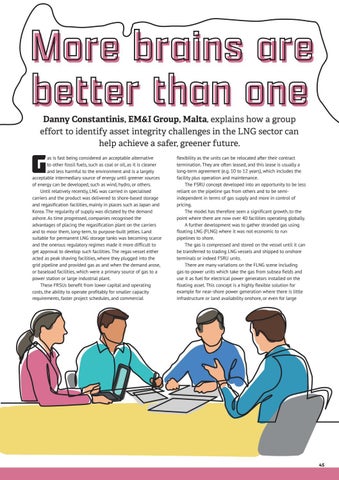Danny Constantinis, EM&I Group, Malta, explains how a group effort to identify asset integrity challenges in the LNG sector can help achieve a safer, greener future.
G
as is fast being considered an acceptable alternative to other fossil fuels, such as coal or oil, as it is cleaner and less harmful to the environment and is a largely acceptable intermediary source of energy until greener sources of energy can be developed, such as wind, hydro, or others. Until relatively recently, LNG was carried in specialised carriers and the product was delivered to shore-based storage and regasification facilities, mainly in places such as Japan and Korea. The regularity of supply was dictated by the demand ashore. As time progressed, companies recognised the advantages of placing the regasification plant on the carriers and to moor them, long-term, to purpose-built jetties. Land suitable for permanent LNG storage tanks was becoming scarce and the onerous regulatory regimes made it more difficult to get approval to develop such facilities. The regas vessel either acted as peak shaving facilities, where they plugged into the grid pipeline and provided gas as and when the demand arose, or baseload facilities, which were a primary source of gas to a power station or large industrial plant. These FRSUs benefit from lower capital and operating costs, the ability to operate profitably for smaller capacity requirements, faster project schedules, and commercial
flexibility as the units can be relocated after their contract termination. They are often leased, and this lease is usually a long-term agreement (e.g. 10 to 12 years), which includes the facility plus operation and maintenance. The FSRU concept developed into an opportunity to be less reliant on the pipeline gas from others and to be semiindependent in terms of gas supply and more in control of pricing. The model has therefore seen a significant growth, to the point where there are now over 40 facilities operating globally. A further development was to gather stranded gas using floating LNG (FLNG) where it was not economic to run pipelines to shore. The gas is compressed and stored on the vessel until it can be transferred to trading LNG vessels and shipped to onshore terminals or indeed FSRU units. There are many variations on the FLNG scene including gas-to-power units which take the gas from subsea fields and use it as fuel for electrical power generators installed on the floating asset. This concept is a highly flexible solution for example for near-shore power generation where there is little infrastructure or land availability onshore, or even for large
45










